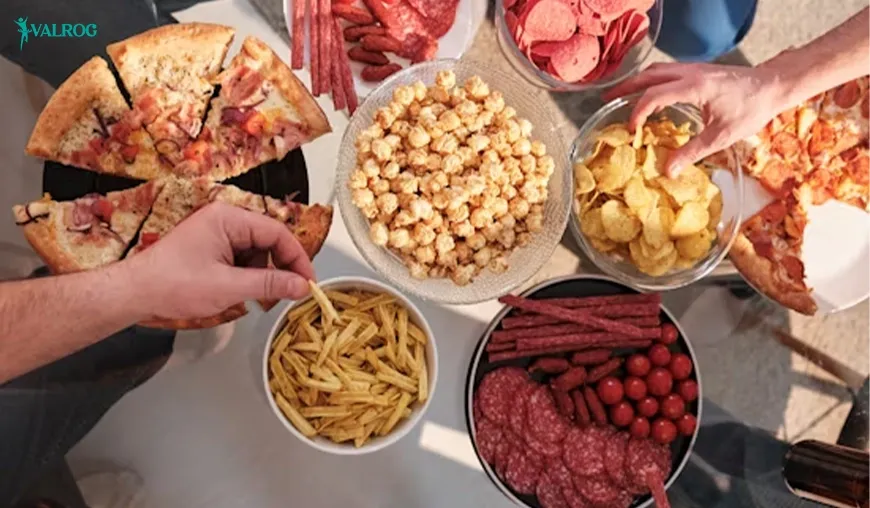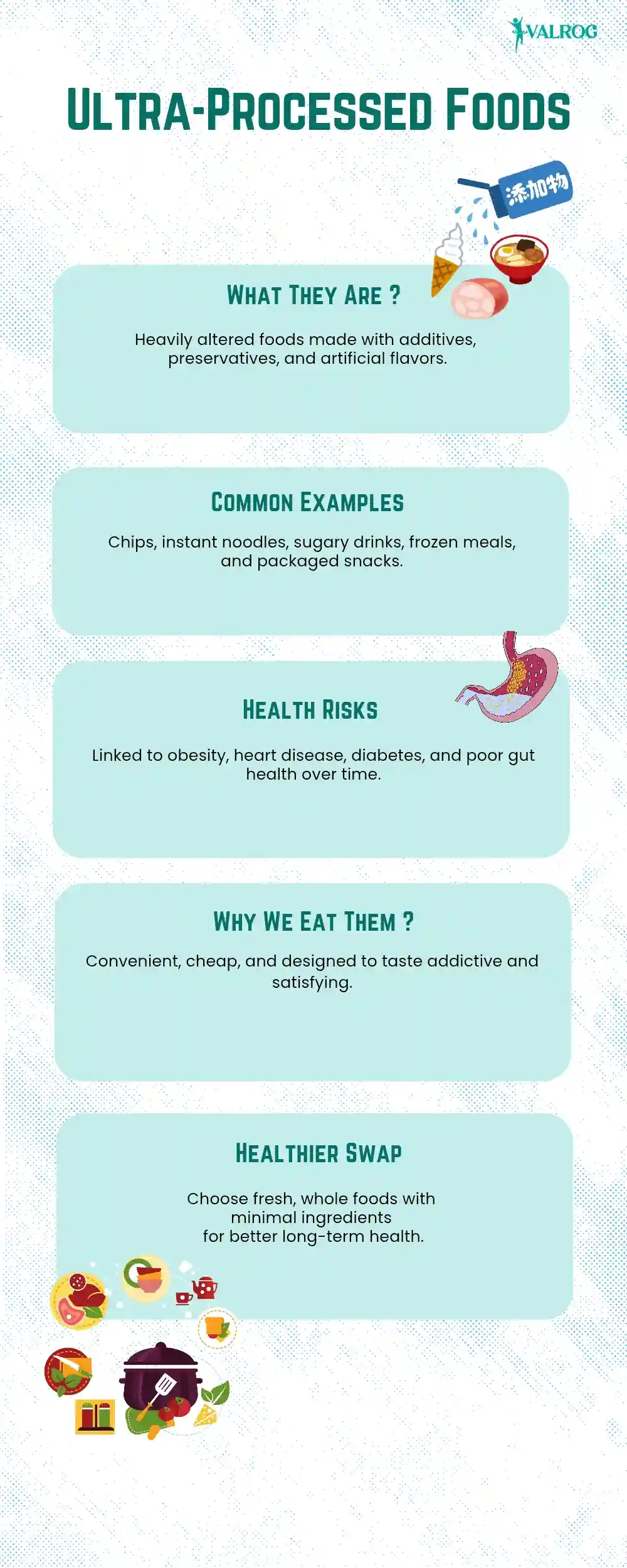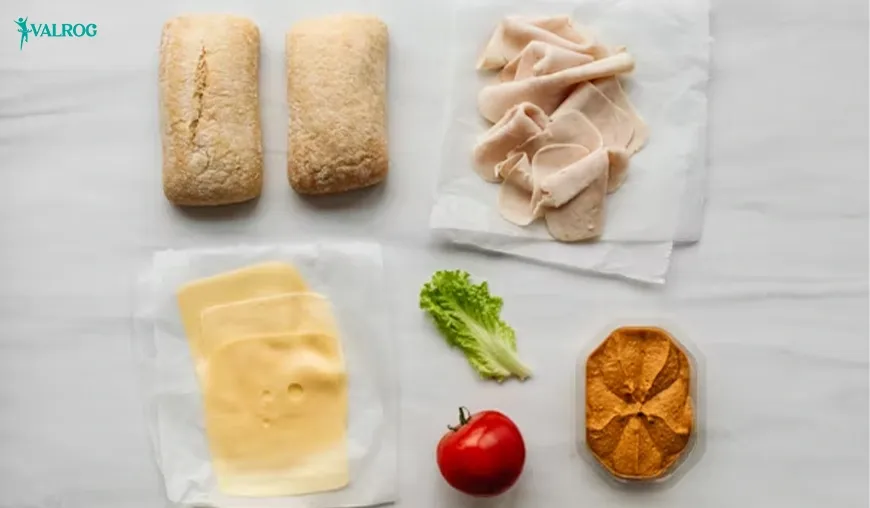You’ve seen them. You’ve eaten them. You might even be addicted to them. Ultra processed foods are everywhere, i.e, in vending machines, lunchboxes, store shelves, restaurant menus, and your freezer etc. They’ve snuck into your breakfast, your late-night snacks, and even the so-called “healthy” meals you trusted. But do we really know what they are?
Let’s be straightforward with the fact that calling food “ultra processed” sounds like a science experiment, right? And yes, maybe that’s exactly what it is.
What is Ultra-Processed Food, Anyway?
Here’s the deal. Ultra processed foods aren’t just regular processed foods with a little extra salt or sugar. They’re factory creations. Built in labs, designed for shelf life, engineered for addiction. They’re not just cooked or frozen, they’re deconstructed and reconstructed. These processes often use parts of food instead of using the whole ingredients.
Visit: 7 Stages of Grief Explained: Emotional Healing After Loss
You can think of it like this: real food becomes parts > parts become paste > and paste becomes something colorful, crunchy, sweet, salty, and strangely satisfying. That’s ultra processed food.
And no, this isn’t just about cookies or soda. It’s way deeper than that.

Define Processed Food vs. Ultra-Processed
Let’s break it down into proper groups:
Group 1
- Unprocessed or minimally processed: These are your apples, brown rice, frozen peas, and raw meat. Maybe washed, peeled, chopped, or frozen. No big changes. Nothing crazy.
Group 2
- Processed foods: These are the foods made by adding things like oil, sugar, or salt to Group 1 foods i.e, canned beans, pickled cucumbers, or a slice of bread made with only flour, yeast, salt, and water. Still recognizable. Still food.
Group 3
- Ultra processed foods? These are Frankenstein foods. Built with stuff you’ve never cooked with at home, maltodextrin, high-fructose corn syrup, hydrogenated oils, flavor enhancers, emulsifiers, and colors with names like E133, etc.
They’re engineered for taste, not health.
A study says that according to the NOVA classification, ultra processing involves techniques and ingredients never used in regular cooking, stuff like protein isolates, chemical flavorings, synthetic colors, and anti-foaming agents.

Discover: What are the Symptoms of a Kidney Stone Disorder?
Ultra Processed Food List: What’s On It?
This might sting. A lot of your go-to snacks probably belong here.
- Flavored chips
- Sugary breakfast cereals
- Soft drinks (yes, even diet ones)
- Frozen pizza
- Chicken nuggets
- Candy bars
- Instant noodles
- Packaged pastries
- Flavored yogurts
- Mass-produced white bread
- Sweetened granola bars
- Processed meat sticks
- Margarine
- Meal replacement shakes
If it has more than 5 ingredients and you can’t pronounce half of them, chances are it’s ultra processed.
Processed vs Unprocessed Foods – At a Glance
| Unprocessed / Minimally Processed Foods | Processed / Ultra-Processed Foods |
| Fresh fruits (apple, banana, berries) | Packaged fruit snacks, canned fruit in syrup |
| Raw vegetables (spinach, carrots, broccoli) | Veggie chips, frozen dinners with sauce |
| Whole grains (brown rice, oats, quinoa) | White bread, flavored instant oatmeal |
| Fresh meat or fish (chicken, salmon) | Chicken nuggets, fish fingers, deli meats |
| Eggs (boiled, scrambled) | Egg patties, pre-made breakfast sandwiches |
| Plain yogurt or milk | Flavored yogurt, sweetened dairy drinks |
| Natural nut butters (just peanuts or almonds) | Nutella, sweetened peanut butter with additives |
| Dry beans, lentils, chickpeas | Canned baked beans with sugar/sodium |
| Homemade soup | Instant cup noodles, canned creamy soups |
| Water, unsweetened tea | Soda, energy drinks, bottled iced tea |
| Cold-pressed oils (olive, avocado) | Margarine, butter spreads with additives |
Is Pasta a Processed Or Ultra Processed Food?
Now for the burning question: Is pasta ultra processed?
The answer’s a little layered.
Plain dried pasta, made with just durum wheat and water, is considered a processed food, not ultra processed. It’s pressed and dried, sure, but no scary additives. So technically, you can eat your spaghetti in peace.
But watch out: is pasta an ultra processed food? It can be; if it’s packaged with cheese powder, instant sauces, artificial flavorings, or modified starches. Is pasta a processed food? Yes. But it crosses the ultra-processed line the moment it becomes “three-cheese explosion microwave pasta with a creamy bacon-flavored dust.”
Explore: Erik Erikson’s Theory Explains 8 Key Stages of Human Growth
Are Noodles Processed Food?
Yep. The same logic applies here. So, are noodles processed food? Absolutely. Especially the instant kind. But let’s be honest. instant noodles deserve their own paragraph.
Are Noodles Processed? And How Processed Are We Talking?
Let’s talk instant ramen, a college favorite and budget lifesaver.
If it’s just wheat flour, water, and salt? Processed, not a big deal. But add flavor packets full of MSG, anti-caking agents, and synthetic beef flavor… Now we’re talking ultra processed food.
So, are noodles processed? Yes. But are noodles processed food in the ultra sense? Only when they come pre-seasoned with a packet of chemical stew. That little silver bag? That’s where the ultra lives.
Why We Can’t Stop Eating Ultra Processed Foods
Here’s the kicker: these foods are built to make you want more.
They’re hyper-palatable, a combo of sugar, salt, and fat, etc. that hits your brain’s reward system harder than grandma’s cooking ever could. The texture’s just right. The crunch, the creaminess, the melt-in-your-mouth sensation; everything is an engineered perfection.
Studies have shown that people tend to eat more calories when given access to ultra processed foods, even when they’re not hungry (Hall et al., 2019). That’s not a lack of willpower, it’s design.

Learn More: What Does Clear Mucus Mean? Snot Colors & Health Explained
Ultra Processed Foods and Health Risks
The evidence is growing day by day. And it’s not pretty good.
- Weight gain
- Hypertension
- Diabetes
- Heart disease
- Digestive issues
- Depression
- Even cancer
Multiple studies across countries confirm that diets high in ultra processed food are strongly linked to chronic diseases. And we’re not talking small risks. We’re talking life-altering outcomes.
Worse, the damage often starts young. Kids are bombarded with ads for these products. Bright colors. Cartoon characters. Free toys. How do broccoli and beans even stand a chance?
The Convenience Trap
Let’s be real about it, ultra processed foods are convenient. They last forever. They’re ready in 2 minutes. You don’t have to chop, season, stir, or clean up, or anything that gets you to do a hassle.
They’re shelf-stable, cheap, and everywhere. And in a world where time is scarce and cooking feels like a luxury, these products slide right into your daily routine. Simple and excellent ease.
But at what cost?
That frozen breakfast sandwich might save you 5 minutes today, but add 5 inches to your waistline by December. That snack bar that claims to be high-protein and low-fat? Flip the label, you’ll probably find more than 20 ingredients, most of them industrial.
Check this out: Medication for Anger Issues: Types, Benefits & When to Consider Them
How to Spot Ultra Processed Foods — Fast
Here’s a simple rule: check the ingredient list. If you see any of the following, you’re dealing with ultra processed food:
- Hydrogenated oils
- Modified starches
- Protein isolates
- Artificial sweeteners (like aspartame or sucralose)
- Flavor enhancers (like monosodium glutamate)
- Food colorings (Red 40, Blue 1, etc.)
- Emulsifiers (soy lecithin, carrageenan)
- Anti-foaming agents
- High-fructose corn syrup
Even something labeled as “healthy” or “low-fat” can still be ultra processed. Buzzwords don’t equal better choices.
The Marketing Machine Behind It All
Make no mistake, ultra processed foods are big business. Multinational corporations spend billions convincing you they’re cool, fun, easy, even healthy.
They sell “energy bars” to gym-goers. “Fruit snacks” to kids. “Meal shakes” for busy professionals. But it’s often the same processed paste under a different wrapper.
Colorful packaging, fake health claims, limited-time offers, it’s all part of the trap. And it works.
So, What Do We Eat Instead?
Not everything needs to come from the farmer’s market. But building meals from real food is easier than you think.
Start here:
- Cook with simple ingredients: rice, beans, veggies, eggs, and fresh meat.
- Snack on nuts, fruit, or plain yogurt.
- Make sauces from scratch: tomatoes, garlic, herbs, and olive oil.
- Avoid packages with ingredient lists that read like chemistry textbooks.
And remember, ultra processed foods aren’t just “bad.” They’re a symptom of how far we’ve drifted from real food. But you can course-correct. One meal at a time.
Therefore…
Ultra processed foods are everywhere, and they’re not going away anytime soon or maybe never, but understanding what they are, how they affect you, and how to spot them is your step one. And there are many more after that, not hard but not too easy either.
You don’t have to go full homesteader or give up pizza forever, but knowing the difference between bread and “bread-like substance” is power. Your body knows the difference; trust it thoroughly.
So next time you’re in the store, take a second. Flip the package. Read the label. Ask yourself: Is this even food? Is this what my body needs?
And if the answer feels fuzzy, it probably isn’t what your body needs. Therefore, take precautions.
